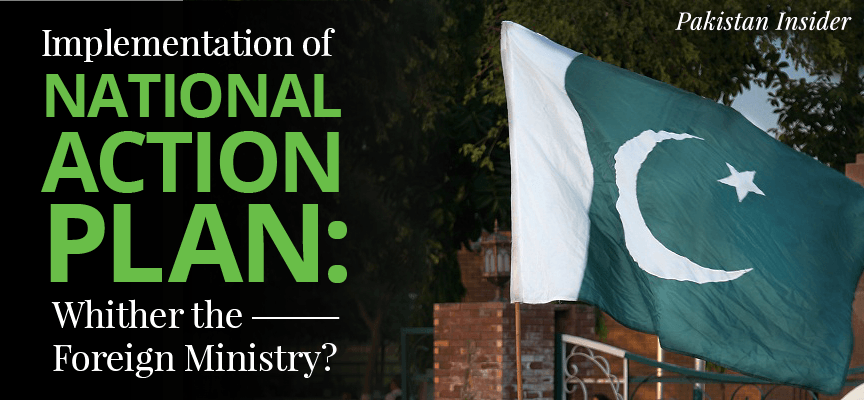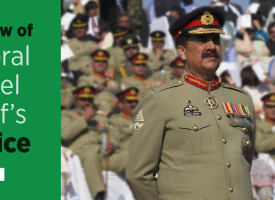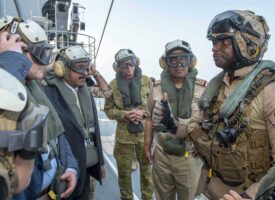On 24 December 2014, Prime Minister Nawaz Sharif in a televised address to the country announced a ‘National Action Plan’ (NAP) to viciously counter the forces of terrorism and extremism. A few weeks later, NAP appeared in the form of a constitutional amendment, empowering the courts to prosecute convicted militants and their financers (challenged recently by a group of mafia lawyers).
What is NAP? It is a consolidated 20-point national agenda to outline steps to be taken to ensure peace, stability and prosperity can once again resurface in Pakistan.
Summary
A summary of each point along with comments for understand is as follows:
Point 1: Execution of convicted terrorists
Comment: Only a handful have been convicted so far, most of them involved in failed assassination attempts on Gen (retd) Pervez Musharraf.
Point 2: Establishment of special trial courts
Comment: Pakistan Army, like their Chinese counterparts, set up a ‘Lawfare Directorate’ (law during warfare) for timely trial and prosecution of terrorists. The directorate is headed by Major General Muhammmad Irshad (Artillery Corps); however, due process of trials, mandated under the 21st Constitutional Amendment, were stopped under pressure from the lawyers-cum-judges mafia.
Point 3: Ensure no armed militias are allowed to function in the country
Comment: With the exception of action against a few political and terrorist groups, the majority of blood-thirsty sectarian organizations (along with their armed wings) in South Punjab and elsewhere are still flourishing. They are sponsored by Arab Gulf states, especially Saudi Arabia, the UAE, Kuwait and Qatar. Similarly, a few armed militias are also sponsored by Iran. In Sindh, separatist groups such as Jeay Sindh Mutahhida Mahaz, Jeay Sindh Qaumi Movement, etc receive support from India. Also, separatist groups in Balochistan receive support both from India and Arab countries. In northern areas, Indian sponsored TTP and Arab-sponsored Al Qaeda are the main perpetrators of terrorism.
Point 4: Strengthening and activation of NACTA
Comment: National Counter Terrorism Authority (NACTA) has become much of a household name now, with every person remembering its name quite well. In operational terms, the institution is visibly dormant and is suffering from an acute shortage of funds from the political government in power.
Point 5: Countering hate speech and extremist material
Comment: Radicalism is the source of terrorism. A person who is brainwashed using extremist content is bound to become a living zombie, ready to become a “martyr”. There are various political, religious and ethnic groups spreading all sorts of hate speech and material, but the most radical and vitriolic of them all are undoubtedly the sectarian organizations who part of the Iran vs. Arab States’ geostrategic turf battles. Groups such as Sipah-e-Sahaba, Sipah-e-Muhammad etc still publish regular content in print and multimedia forms against their rival sect.
Point 6: Choking financing for terrorists and terrorist organizations
Comment: This is the crux of all the problems seeks to address. Unless the flow of cash and other forms of payment to fund extremist, militant activities is not monitored and blocked, branches can be cut again and again; finances are the root of the problems. Millions of dollars come each month to madressahs across Pakistan from Iran and Arab Gulf states either through intermediary channels or through front organizations operating as covert distributors of black money.
Point 7: Ensuring against re-emergence of proscribed organizations
Comment: NACTA had uploaded a list of proscribed organizations on its website which was taken down soon when several influential political and religious lobby heads pressurized the Interior Ministry to be careful of treading in dangerous waters. As expected, the civilian government succumbed to this pressure. Several hundreds of these organizations were named, including Jamaat ud Daawa, Lashkar-e-Taiba, Sipah-e-Sahaba, Jafaria Tehreek, Lashkar-e-Islam, etc. Ensuring they don’t re-emerge is another thing, taking decisive action against them is still pending.
Point 8: Establishing and deploying a dedicated counter-terrorism force
Comment: This agenda has to see the light of day. NACTA itself is dormant, police units in some major cities of Pakistan have Counter Terrorism Departments, the Punjab province has set up a dedicated Counter Terrorism Department (CTD) with corporals and officers specially trained by the military commandos; however, unlike other civil law-enforcement agencies such as the police, the CTD too has been victim to cronyism. The “sifaarshi” recruitments in this department under the fake cover of “transparent” NTS exams is a joke on the people of Pakistan.
Point 9: Taking effective steps against religious persecution
Comment: Hate and violence against minority religious communities is still thriving; in fact, it has gotten worse with reports of alleged blasphemy charges, etc still leading to several deaths. The traditional maulvi still calls the shots in rural areas, matters from which the policy try to distance themselves and avoid “controversy”.
Point 10: Registration and regulation of madrassas
Comment: Implementation on this agenda is pure lip-service; the Government of Pakistan subdued to pressure from foreign-sponsored religious lobbies in Pakistan who, in open words, warned of dire consequences if madrassa affairs were interfered in. To date, the political government is simply unwilling to displease the mullah-cracy in Pakistan.
Point 11: Ban on glorification of terrorism and terrorist organizations through print and electronic media
Comment: This agenda sounds very idealist, but it is very much possible. All that’s required is strong willpower to enforce the writ of the state; sadly, this “writ” cannot be enforced in the media also. Sectarian and sub-nationalist bigots continue to preach hate and incite killings against their targets.
Point 12: FATA Reforms
Comment: This agenda was initiated with full enthusiasm in the beginning but eventually vanished into thin air, as if it was never a part of NAP. To this day, FATA remains in a state of crises, with the political government refusing to focus on the proper rehabilitation of Temporarily Displaced Refugees (TDPs), reforming of the civil society infrastructure and administration in FATA and engaging in effective anti-narcotics regulation.
Point 13: Dismantling communication networks of terrorist organizations
Comment: Besides domestic communication networks, the Government of Pakistan has not paid attention to the problem of communications with foreign elements which sponsor these terrorists.
Point 14: Measures against abuse of internet and social media for terrorism
Comment: On an overall, only about 1% of extremist, terrorist organizations have been prohibited from publicizing their radical content on the Internet and social media. Hundreds of pages operated by untouched groups still operate on a regular, in fact, daily basis. A page operated by Group X incites murder and hate against Group Y and vice versa. NACTA is primarily responsible to monitor and do surveillance of such miscreant online elements.
Point 15: Zero tolerance of militancy in Punjab
Comment: We have yet to see that “zero tolerance”. South Punjab, the hotbed of extremism and sectarian radicalism, is abundantly infested with terrorist organizations responsible for killing civilians and soldiers alike. Their seminaries remain untouched while all the focus is put everywhere except Punjab.
Point 16: Taking the ongoing operation in Karachi to its logical conclusion
Comment: V Corps Commander Lt Gen Naveed Mukhtar and DG Rangers Sindh Maj Gen Bilal Akbar are fully committed to this agenda by action and not just words; however, unless the provincial government in Sindh musters up the shame and realization to provide political backing to this operation, the picture will remain grim.
Point 17: Balochistan reconciliation
Comment: Recent reports about separatist militant commanders and their subordinate rebels laying down arms in return for pardon is welcoming news. It proves beyond doubt how political willpower can achieve objectives which even military operations couldn’t. However, the main troublemakers i.e. Hyrbyair Marri, Mehran Marri and Brahamdagh Bugti are still not willing to talk since their sponsors in New Delhi do not want to lose their prized strategic assets yet.
Point 18: Dealing firmly with sectarian terrorists
Comment: This long-sought agenda is still pending. Sponsored sectarian organization are still flourishing.
Point 19: Policy to deal with the issue of Afghan refugees
Comment: The political government has taken measures to crackdown against illegal Afghan refugees and those who are suspected of involvement in terrorism inside Pakistan. NADRA has been directed to ensure their complete registration but proper diplomatic coordination with UNHCR on this critical issue is yet to assert any strong state demands from Pakistan to send them back.
Policy 20: Revamping and reforming the criminal justice system
Comment: Despite the constitutional amendment and special-circumstantial legal mandate by law, military organizations face stiff resistance by lawyer-and-judge mafias whose financial interests are at stake. There is severe opposition to any proposed reforms in the criminal justice system and the political government seems helpless in reining in these forces of opposition.
Where is the Foreign Ministry?
Pakistan’s Foreign Ministry (Ministry of Foreign Affairs, Islamabad) has remained criminally silent since Day 1 of NAP’s announcement. As the premier institution responsible for representing Pakistan internationally, and advocating for its interests, it has neglected any or all chances of liaising with countries who have some level of involvement in terrorism inside Pakistan.
Consider the following: In the above-mentioned summary of NAP’s agenda, Points # 3, 5, 6, 7, 10, 13, 14, 15, 16, 17, 18 and 19 (12 out 20 points) are issues which have direct or indirect foreign relations attached with their implementation. A few examples below will help understand the issue better:
• Support to TTP by Indo-Afghan intelligence
• Support to Jaish-ul-Adl by Saudi Arabia
• Support to sectarian madrassahs by Arab Gulf states and Iran
• Support to ethnic militant organizations in Karachi by India
• Support to Baloch separatists by India
The above is just a small preview. The canvas is larger, more horrible and utterly embarrassing. In a responsible, ideal situation, the Government of Pakistan should have formed inter-ministerial liaison committees in important stakeholders for counter-terrorism such as the MoFA (for foreign liaison), FBR (for financial regulation), Ministry of Religious Affairs, Ministry of Interior and Ministry of Defence. The open secret is that bureaucratic red-tapism and turf wars are still prevalent, which is why the civilian infrastructure to implement NAP is in shambles; the political parties were never serious anyways.
Ideally, a “NAP Foreign Working Committee” should have been setup at the MoFA with representatives of intelligence agencies, Ministry of Interior, FIA, NACTA, etc. MoFA should have been tasked with coordinating the external linkages to terrorist organizations, their financers and supporters. It chose to remain dormant and let the domestic security organizations lurk around the dark themselves. Why would the MoFA want to take additional burden on itself anyways? If they offended any foreign diplomat or dignitary, who would invite them to lavish receptions in the Diplomatic Enclave? Who would help the MoFA project its image as the most modernist ministry in the Government of Pakistan?
Prime Minister Nawaz Sharif has the additional portfolio of Foreign Minister, since he assumed charge as premier. His lack of seriousness in committing any suitable funds for NACTA is visible, he may well have many to-do things up his sleeve, why doesn’t he appoint a full-time Foreign Minister to establish and oversee workings of the much-needed NAP Foreign Working Committee? Apart from the usual anti-India and rhetoric and generally soft statements issued by the Foreign Office, why does the MoFA not uphold an a determined diplomatic posture and liaise with such countries as India, Afghanistan, Arab Gulf states and Iran to put an end to their violent frolicking in Pakistan?
Conclusion
The Armed Forces and Interior Ministry cannot be solely held responsible for the regrettable lag in NAP’s full implementation. Unless Pakistan’s Foreign Ministry (MoFA) is given the frontline assignment to manage foreign relations with regards to domestic terrorism, no meaningful or permanent peace will prevail. Pakistan has had enough of warming up to its “brothers” and “neighbors”. In critical matters of internal security, compromises are not an option but a disgrace to one’s nationhood.
Featured image credit: Flickr/michaelfoleyphotography








No comments!
There are no comments yet, but you can be first to comment this article.